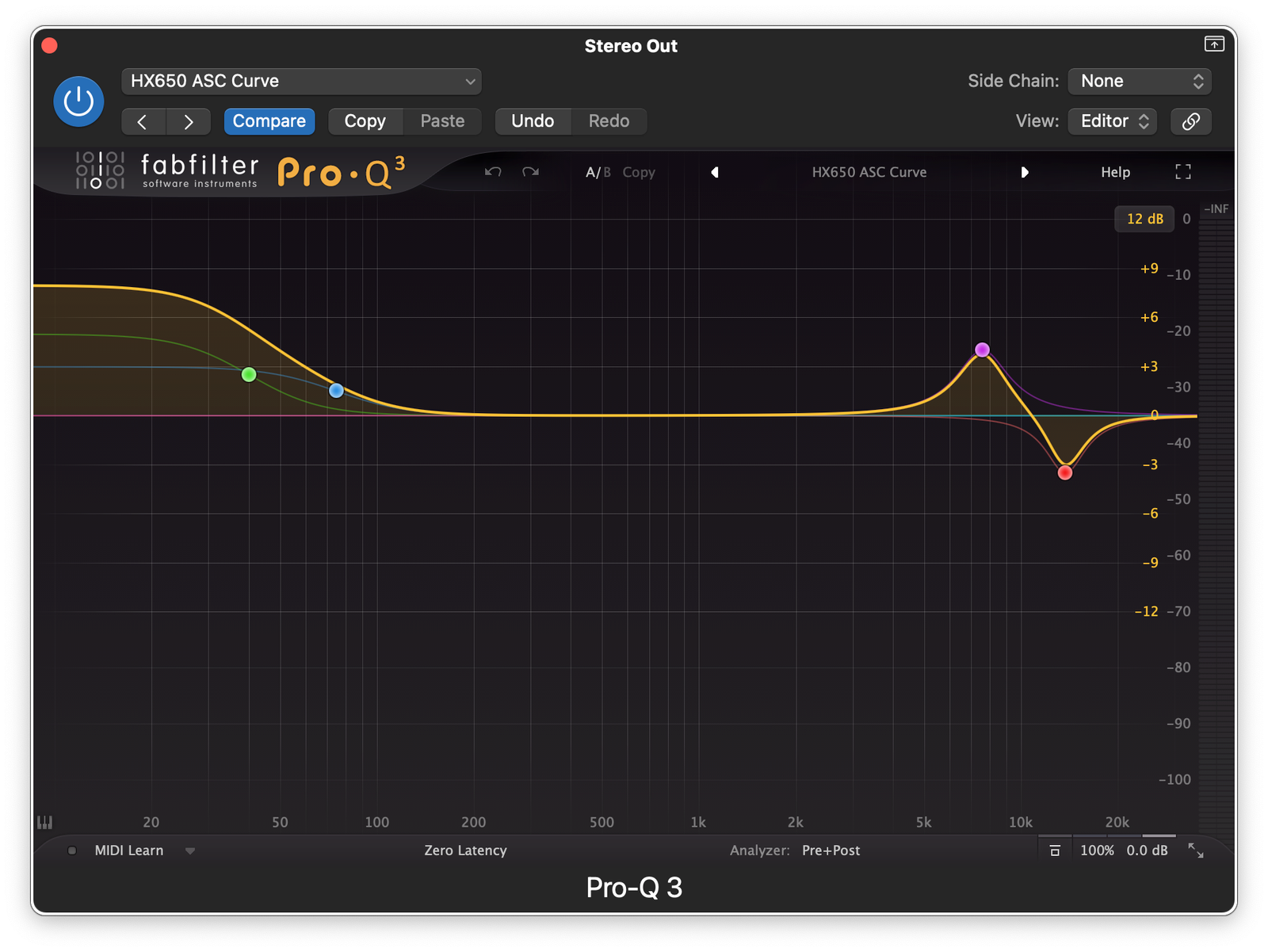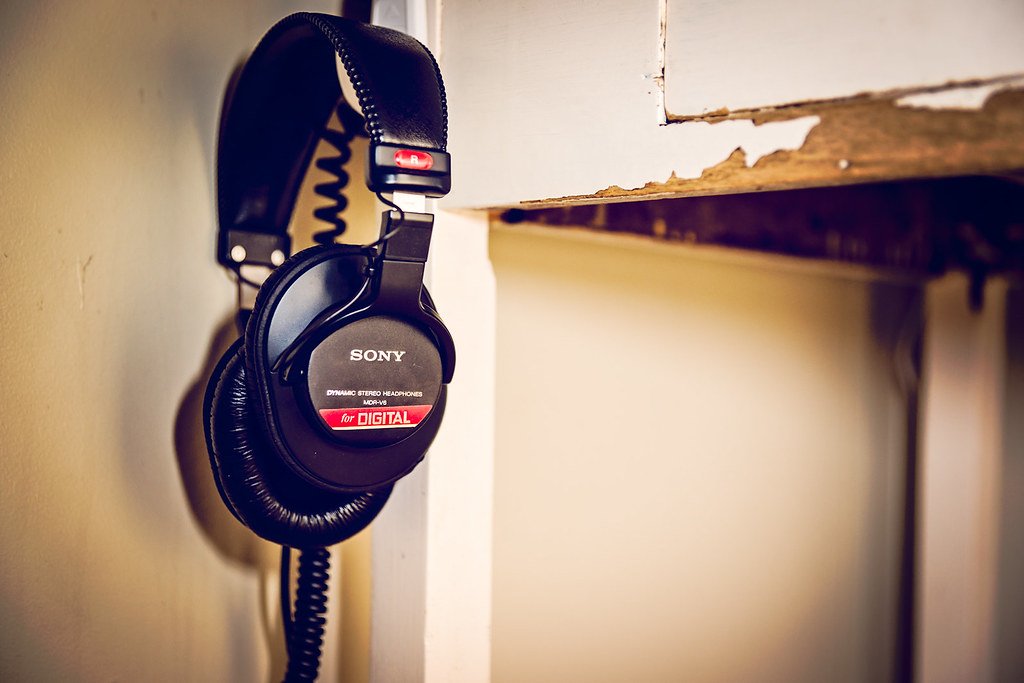Image Credit: “Sony Headphones” by Hugo y Charli is licensed under CC BY 2.0.
If you didn’t get the reference for the title, go here.
There is a lot of info to unpack here so I’m going to break this up into two posts. This part focuses on headphone terminology, the issues with using headphones for creation and mixing, and how to overcome or correct the foibles for free. Part Two will show more elaborate (re: $$) solutions to creating and mixing on ‘cans’.
Mixing music and audio is an artform unto itself – and like any other learned skill takes years of practice to achieve the results you hear on the Streaming Services or a physical product like vinyl or CD’s. Once considered completely out of the question, mixing on headphones is a viable method in today’s modern music production realm, and unfortunately is also a messy rat’s nest of confusing and conflicting information where you encounter things like: ‘You can, no wait – you can’t…’ ‘Okay, well you can if…’ ‘You’ll need really expensive headphones to make a mix translate.’ ‘These are the only headphones you’ll ever need.’ ‘You need at least 10 different pairs depending on what you’re mixing and what genre it’s in…’ ‘Just get a really nice set of speakers and you’ll never need them.’ ‘Here’s my review of the best headphones in the Solar System – please like and subscribe…’ It’s time we cut through the myths and the controversies to find some solid facts.
There is an old adage that ‘the best camera you own is the one in your pocket’. The same can be said of headphones – or speakers for that matter. The best ones you have are the ones you’ve been using for ages and you know all the foibles and quirks, and how to correct those to achieve a great mix. Andrew Scheps uses a set of Sony MDR-7506’s (‘cheapy’, yet usable cans you can find for about $100) and says he never uses any kind of alterations since he doesn’t want the sound to be perfect. I’ll wager he’s been using them for decades and just knows them really well, so why would he change what works for him?
If you’ve been using a set of headphones for production and bouncing a mix sounds on other systems just like it did when you were listening to it in your production software – you’re golden. You can stop reading here and go find some nice cat pics for the rest of the day. But – if you’re like many who just cannot use monitors (speakers) to reference your tracks because of living conditions, cost, or even space considerations, headphones are a perfect choice for creating, mixing, and finalizing music. Regardless of what you’ll watch in some ‘Audio Influencer’ video, it can be done, it is done in the modern mixing world, and it can even done on the cheap. There are many, many professionals in the music industry who use or have completely switched to headphones (or IEM’s – more on this shortly) for what they do. It’s not the taboo that it used to be, and certainly shouldn’t be as complicated as it’s become.
I’ve been on a quest for over a decade into finding the ‘perfect headphone setup’ for my little spot here in SWland. I have several sets of monitors, but rarely use them. My youngest has sound and hearing issues, and even at incredibly low volumes he tends to complain about the noise. So if I want to mix at the homestead, I have to do it on headphones. My trip down this particular rabbit hole will hopefully help others out there with similar issues.
My goal here is to cut through a lot of the BS and get to some practical and economical ways to make the best out of creating and mixing using just headphones. It’s based on many years of trial and error, trying many different methods and solutions, and focusing my personal songwriting and mixing to monitoring on nothing but headphones over the last decade plus. Like everything else here at SW, these are my opinions and your opinion will most likely be very different (more on why just below). I will overlook some software solutions (more about this in Part Two) and since any speaker system is a very personal thing (everyone hears differently and has preferences that vary widely when it comes to sound reproduction) I will keep the science bar as high as I can (lots of references in here!) and the personal preferences to a minimum (and noted when they are.) Any mistakes or errata will be corrected with addendums below the post, including software updates I deem fit for the scope of these articles.
We can define headphones as the things with the blobs that go on or over each ear and usually some kind of band that goes over your head to keep the blobs in place. We can also define them as ‘earbuds’ which are smaller things that go in your ears and might have wires that go into a music player or audio interface. They can also be wireless like the ubiquitous AirPods or GalaxyBuds. A fancier term for these is ‘In-Ear Monitors’ (IEM’s for short), which originally came from the live sound and show production side of things to replace loud and feedback-causing stage speakers so the band or artist can hear themselves playing onstage without deafening volumes. In-Ear Monitors are typically made from molds (or hi-res scans) of your ears to ensure a perfect fit, but they can also have the little silicone bulbs or foam tubes to help seal them against outside noise. For these articles we will use the broad term of ‘headphones’ for anything you can wear that sends sound into your ears for listening.
When we are talking about ‘typical’ headphones (the blobs (or cups as they are actually called) with the speakers in them that go on or over your ears) you need to understand that there are two basic types: closed-back and open-back. And both of those can have about twenty gazillion different driver (speaker) types and designs. We don’t need to worry so much about what the driver type is, but knowing whether you have closed- or open-back headphones can make a difference to your sound.

Above are two of my many sets of ‘cans’… On the left are my Hifiman Sundara Planars (that’s the driver type) and are open-back headphones (note the grill that allows sound to pass through). On the right are my well-worn and trusted ‘daily driver’ Audio Technica ATH-M20x closed-backs (note the back is solid to keep the driver sound from getting outside the cup and outside sound from getting in.) The general rule for usage of these is pretty simple: you should use closed-back ones for recording (especially with microphones) and/or for editing where you really need to keep outside sounds to a minimum. These are my ‘go to’ headphones for pretty much everything. Open-back cans typically have a better ‘soundstage’ (a term for the width of field the mix sound like from left to right and even top to bottom) and have a better all-around frequency response due to the fact that they are not sealed which allows the drivers to move (this is called ‘excursion’) more naturally than their closed-back brethren. I like to use my open-backs (like Sennheiser HD650’s or Hifiman Sundara’s) for final mix checking for their clarity and soundstage.
Some more info: open-backs need to be treated with a little more care than Closed-Back ones due to the fact that the vents on the outside of the cups can allow both moisture and minute dust particles to get inside the enclosure, so either get a case for them or just leave them in a safe spot in your studio until you need them.
On IEM’s: Like all technologies, In-Ears were once customized and expensive. The ‘ChiFi’ market has exploded with incredible sounding transducers (earphones) at crazy-affordable prices. Crinacle is your guide here, and has done a lot of testing to help you navigate the maze of options. He is also on The Tube of Yous for your entertainment. His sense of ‘balanced sound’ is a bit more hyped than mine personally (he likes the big bass and more top end than I prefer), but his knowledge is (as far as I’m concerned) the best on this topic. Also – he’s all into user correction to make them more to your liking.
One final thing: We’ve all heard about the dangers of hearing loss due to loud listening with earbuds. IEM’s can push even more sound into your ear canals so keep those levels tempered and listen loud for final checks only! Take a break afterwards to give your ears time to reset. This should be done with any playback system honestly.
Okay. With some basics out of the way, let’s get into issues and solutions.
Let’s say you have a decent set of headphones you’ve been using for music making. You like the feel of them, the fit and finish, and you like the sound they reproduce while you’re creating. However, your mixes just don’t sound as good in a car, or an mp3 player, or a boombox as they did with your headphones. They might be defective or damaged headphones if you notice that one side sounds louder that the other, or sounds aren’t as ‘thumpy’ or ‘punchy’ or ‘bright’ on one side than the other. But if you’ve bought a set of headphones within the last decade, they are almost certainly pretty well constructed – both physically and sonically. Sound reproduction has come a long way since I started using headphones in the dark ages decades ago.
To put this into the tl;dr zone – you probably do not need a new set of headphones. What you need to address is why your tracks don’t translate to other systems when mixing on them.
Remember when everyone was using Beats headphones like a decade ago? They sounded pretty good and that bass was glorious. However, if you ever mixed on those you soon realized that the bass that came out on other systems was weak and rather underwhelming by comparison, and the mix wasn’t quite right. The headphones were fooling you into thinking there was something there that wasn’t… This happens with a lot of headphones until you get to know their weak points.
In general, this is a problem with any speaker system. Everyone hears differently and you have to understand what the monitors are telling your ears and brain, and how to compensate for that when you are listening back on other playback systems. This is why it’s always a good idea to reference your mixes on a few other devices to check how they sound and then make adjustments back in the mix to compensate for those issues. Any engineer worth their salt does this until they truly understand their speakers – and even then they will continue to reference on other systems to make sure their mixes translate to ‘the real world’. Is the mix perfect on the ‘big speakers’ but the vocal is getting lost on cheap set of earbuds? Perhaps bringing the vocal up a bit and try another mix (or fine tune that ‘pocket’ for the vocals to sit into) helps them sound equally good on both. Maybe the bass sounds incredible on your nearfields but sounds ‘muddy’ or ‘boomy’ in a car stereo? You’ll need to address that. But once you get a mix that sounds great on your speakers, and headphones, and a couple of other trusted systems (a car stereo, a bluetooth speaker, or a cell phone) then you are in the zone. Always check mixes on anything you have available to make sure they sound great on all of them.
This technique really is the key to getting great mixes, but it takes time and practice to get right (like everything else we want to do in life!) – but there is something simple you can do that might help you speed things up a bit. We’re going to Calibrate your headphones to make them sound more like what a good set of ‘professional’ speakers do. And the best part? It won’t cost you a penny.

Above is a picture of FabFilter’s Pro-Q3 with my ‘Harmonesque’ EQ curve for a set of Sennheiser HD-650 headphones. You don’t have to own a ‘fancy’ EQ for this – any Parametric EQ in a DAW will work for this technique.
There are many audio engineers who swear by correcting their headphones, and just as many who don’t (like the Andrew Scheps example above, I’ll bet they been using the same pair forever and just know them inside and out). Some (like yours truly) use 3rd Party software to address the discrepancies of their headphones, and this will be talked more about in Part Two. There are others who simple calibrate their headphones to something called ‘Harmon’.
The Harmon Curve is a measurement of the way music speakers should sound to the average listener (many people were tested to make this curve) and adapting the headphones’ response to match this curve (in theory) will help them sound more like the ‘perfect’ playback system. Emrah Celik is one of the Multi-Platinum engineers who swears by using Harmon with his headphones, so this isn’t some snake oil… There’s a lot of techie info here if you want to dig deeper.
Now here’s the cool thing about The Harmon Curve: There are databases out there to get the specific boosts and cuts for pretty much any set of headphones. Enthusiasts with (rather expensive) test equipment have gathered as many sets of cans as they could and measured them to get the frequency and gain settings to match The Harmon Curve – this Reddit Thread has the bulk of the info. (A search for ‘Oratory1990’ might bring up the latest version if that thread is missing). As I mentioned in the above pic, any stock Parametric EQ in your DAW can be programmed for these curves (depending on the number of bands needed you might have to use multiple EQ’s – say one for the bass/mids and another for the mids/highs, but it will work fine when there are in series.) Save your EQ Preset(s) and they are ready to use the next time you are mixing with your headphones. Even cooler is the AutoEQ Project that can automate this process even further. Check this link for more info on Harman and AutoEQ.
Remember this about headphones: there are a lot of them from an ever-expanding cadre of companies, with more introduced pretty much every day. Manufacturers develop and refine technologies which leads (hopefully) to better sound reproduction. Swaths of Marketing Minions hype features to make you buy their product (or products) to keep the ‘number goes up’ bottom line. Finally, the Interwebz® gets their hands on them and countless articles and videos are produced to make you believe that just this one new thingy is going to make you sound like your favorite artist or engineer. There’s a lot of competition for your ears (and money) in this space, so manufacturers are always trying to stay on top of the what they think their listeners want (or try and persuade them to get what think they want) so every single pair will have a different sound to try and capture some faction of this market. As I said above, speakers and headphones are a very personal thing and even though we can scientifically measure them that doesn’t mean they sound great to you. Learn what you have and love already until it doesn’t do what you need it to anymore. Only then look for new solutions.
With your corrective EQ set up and saved, all you have to do is put this EQ (or EQ’s if you need them) as the very last Plugin(s) on your Stereo Out or Master Bus (can we change this sorely outdated terminology please?) and you will be listening to your mix through Harmon-corrected headphones. Just remember to Bypass or Disable these EQ’s before you do a bounce or your mixes will sound out of balance!
After you bounce out your mix, don’t forget to check it on other systems to see how your mix translates across systems. Hopefully, this will ‘jumpstart’ your journey to get better and more translatable mixes from here on out. In my tests using several different sets of headphones, the EQ fixes do seem to ‘smooth’ things out a bit and do help with mix translation, but if you are used to how your headphones sounded before calibration it will take a bit of time to get the hang of the ‘new sound’. Keep at it to see if works for you, and it’s as simple as not inserting the EQ’s on the Stereo Bus if you prefer your cans the way they were. And it didn’t cost you anything to try. 🙂
Told you there was a lot to unpack! But there is still much to cover – we haven’t talked about the another thing that needs to be addressed when mixing on headphones (even using Harmon), but that’s unfortunately going to require you spending some money to make this happen unless I can find a usable, free, cross-platform Plugin that emulates this. My search before and during writing this turned up very little (and doesn’t meet all the criteria above), but I’m still digging. We’ll also look into ‘All-In-One Solutions’ that are going to hit you in the wallet, but have a lot more power and capability in Part Two.
Until next time…


Leave a Reply